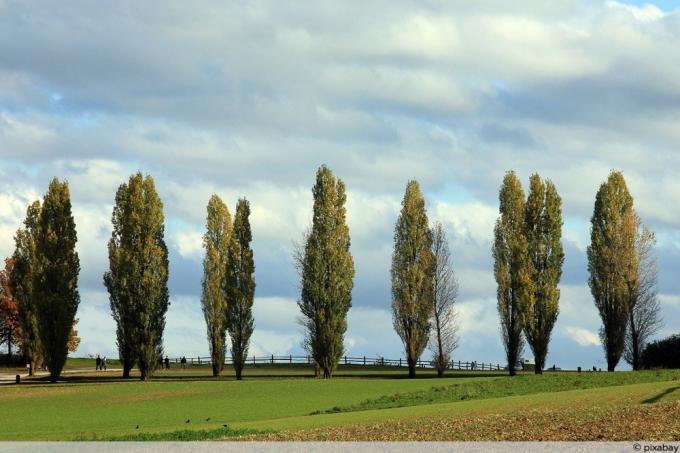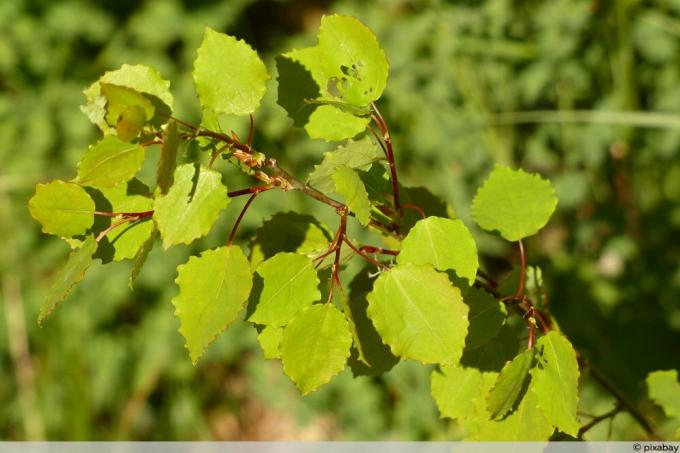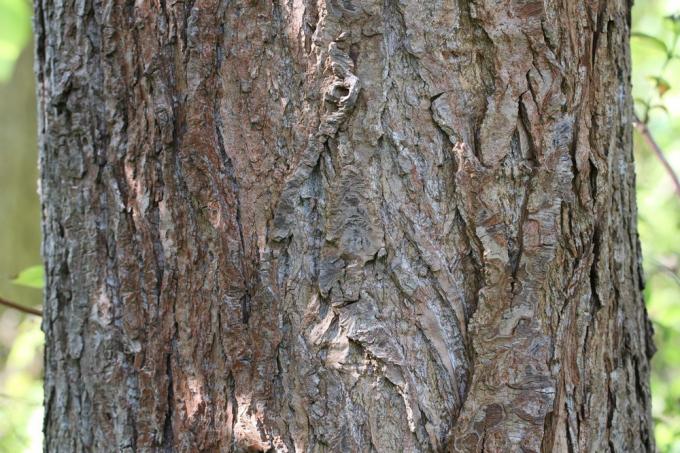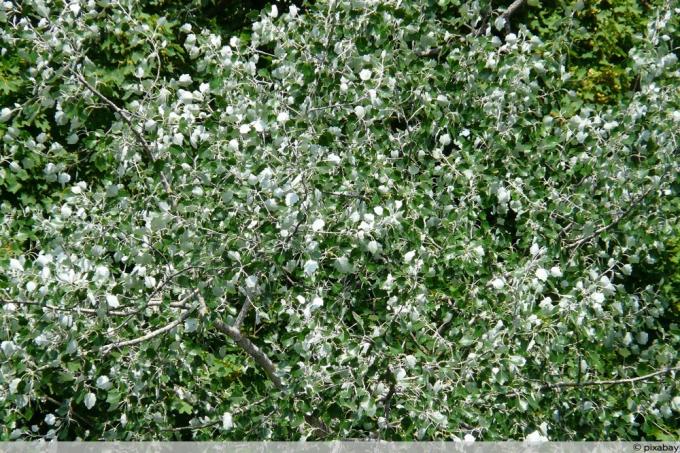
table of contents
- Characteristics
- Location
- floor
- Sowing / seeds
- Planting
- Fertilize
- to water
- Cut
- Overwinter
- Multiplication
- Pests
- Diseases
Profile and care information open +conclude -
- Flower color
- White
- Location
- Partial shade, shady, sunny
- Heyday
- March April
- Growth habit
- upright, expansive
- height
- up to 40 m high
- Soil type
- sandy, loamy
- Soil moisture
- moderately dry, moderately moist
- PH value
- neutral, weakly alkaline, weakly acidic, alkaline, acidic
- Limescale tolerance
- Calcium tolerant
- humus
- rich in humus
- Poisonous
- no
- Plant families
- Willow family, Salicaceae
- Plant species
- Medicinal plants, deciduous trees, useful plants
- Garden style
- Natural garden, park
The poplar is a popular avenue tree thanks to its slim, upright growth. However, it also works extremely well as a stylish solitaire in the home garden. Although their flowers are generally considered inconspicuous, many hobby gardeners like the colored kittens. The filigree, heart-shaped leaves also prove to be extremely decorative.
Characteristics
- German name: Poplar
- Latin name: Populus
- Family: Willow family (Salicaceae)
- Distribution: Europe, Asia and North America
- Flowering period: March - April
- Flower color: white
- Flower shape: catkins
- Height: up to 40 m
- Age: up to 300 years
- Winter hardy: down to -24 degrees Celsius
Location

If you want to plant a poplar in the garden, you should first and foremost have enough space for the tree. The future is also to be considered, because the splendid tree can reach an age of up to 300 years. The poplar not only reaches a considerable height, but also needs a lot of space in the ground for its considerable roots. This is very aggressive and likes to displace neighboring plants quickly. Sidewalks, pipes and house walls should also be at a sufficient distance from the poplar. Because of these properties, it is highly recommended to plant it as a solitary tree in the center of a lawn.
- lots of space
- sunny and warm
- south-facing location ideal
- preferably near the water
floor
The poplar likes to be moist, which is why it is best planted near water. In the home garden, for example, the proximity of a pond bank is ideal. However, this is not absolutely necessary, as the poplar actually grows well on all soils, as long as they are moist enough. If you don't have a pond, you may have to water it manually. Apart from the moisture in the soil, the tree also prefers the following soil properties:
- meager to nutrient-rich
- pH value: acidic or basic (4.9 - 8)
- rich in humus
- lime tolerant
Sowing / seeds
Sowing is only recommended to a limited extent, as this is generally taken over by nature. Poplars use the wind to help spread the poplar seeds. Accordingly, the seeds are not ordinary, small granules, but rather have a white, downy head. Because this makes it possible for the seeds to be carried a few meters by the wind. In addition, the poplar seeds float well and can be spread by nearby rivers and streams.
Planting

If you want to plant a poplar in your garden, you can choose between a full-grown specimen as well as pre-grown cuttings and young trees. Mature trees are planted in autumn, whereas young trees are preferably planted in spring. It is advisable to choose young trees, as these establish themselves more easily. In addition, the young trees grow relatively quickly into robust and handsome trees. To plant the young trees, it is best to proceed as follows:
- Dig out a sufficiently large planting hole
- The thickness of the top floor should be around 80 cm after installation
- Loosen the substrate
- add gravel or sand if necessary
- Basic fertilization with the addition of compost
- Drive in the support post
- Place the seedling upright in the planting hole
- Sludge the earth well
- Tie the poplar to the support pole
Support pile
In the case of young trees, it is generally advisable to equip them with a support post when planting them. This means that the young trees are secured in the event of a storm and protected from tipping over. Accordingly, they can anchor their roots better in the ground and the tree can grow quickly. While large trees are usually supported from a three-pillar tripod, a vertical post is usually sufficient for young trees. The best way to support the young deciduous tree is as follows:
- Drive the support post into the ground at an angle
- about a hand's breadth away from the trunk
- on the side of the main wind direction
- Tie up the young tree
- z. E.g.: with a coconut rope
- tie about 1 - 2 hand's widths below the crown
Fertilize

Ideally, the poplar is provided with a basic fertilization in the form of compost as soon as it is planted. This is usually sufficient, because poplars do not necessarily need additional fertilization. If you still want to provide the deciduous tree with additional nutrients, you can leave the fallen leaves in the root area or spread some compost in autumn.
- Basic fertilization with compost when planting
- leave falling leaves
- if necessary, compost fertilization in autumn
to water
Poplars are generally considered to be very hungry for water, which is why they feel particularly comfortable near water. In this case, watering is basically only necessary in persistent dry phases. However, if you don't have a garden pond, you should water the thirsty poplar manually, preferably daily! It is also necessary to water seedlings and young trees regularly in the first few weeks of planting.
- pour especially in persistent drought / heat
- preferably early in the morning or late in the evening
- Avoid waterlogging!
- Soil shouldn't dry out
Cut

Poplars are very easy to cut, but do not necessarily have to be cut! Those who want a beautiful crown to develop and the trunk to be free should cut the lower branches for the first few years. If, on the other hand, you want the branches to line the tree away from the ground, you should cut the branches regularly. Hobby gardeners who want to forego a cut entirely should at least remove rotten branches and dead wood.
- Autumn is the best time to cut
- The tree's sap flow decreases
- Regularly remove rotten branches and dead wood
Note: A topiary is recommended for avenue trees and artistic solitaires!
Overwinter
The poplar is hardy and can cope with proud temperatures of up to - 45 degrees Celsius. Accordingly, the tree is generally well armed against frost and cold, so that additional frost protection is usually not required. While frost does not pose a threat in winter, game browsing is all the more dangerous for young trees. Because the bark and bud of young trees are often nibbled on by a wide variety of animals. It is therefore advisable to protect young trees from being bitten by game during the first two to three years in winter. The best way to do this is as follows:
- Wrap the trunk with a burlap sack
- Tie up the sack
- Leave on the tree until early spring
- then remove it again
Multiplication

These are best taken from a well-exposed treetop of a relatively young mother tree (10-15 years old). It is also possible to harvest cuttings from old and weak trees, but this is usually associated with a high level of technical effort. Likewise, side shoots or crooked side branches from the crown area serve as cuttings, but the growth rate is usually significantly lower. The cuttings chosen should not only have certain properties, but also be prepared for propagation:
- Width: about 8-12 mm thick
- “Pencil thickness” is the lower limit
- at least 4 eyes per log
- Cut cuttings to 20-30 cm
- top cut just above one eye
- lowest cut just under one eye
storage
After the cuttings have been obtained, they can either be used directly or alternatively stored. In order for the cuttings to survive storage, however, certain factors must be taken into account:
- Bundle cuttings
- Layer the bundles completely in sand or sawdust
- This prevents water loss through interfaces / bark
- Store well ventilated, otherwise risk of mold!
Knock in cuttings
The best mating date is in spring, when the ground is open and no more periods of frost are to be expected. If you want to maximize the chances of success of the propagation, you should also take an essential precaution, namely attaching a black PE film (0.55mm). This is laid out flush with the floor at the future location and ensures that the soil warms up well and the moisture is retained in the soil. These factors promote early root growth. It should not be forgotten that, thanks to the film, weed growth is prevented almost all year round and nothing stands in the way of the tree growing.
- Loosen the substrate
- add humus-rich potting soil if necessary
- Attach the PE film flush with the floor
- Drive in cuttings
- Distance about 15-20 cm
- so deep that about 2 cm protrude from the earth
- then water abundantly
Pests

Poplars are very likely to be attacked by a wide variety of pests, which, however, can be controlled well in most cases. Some pests only leave behind optical damage, so that control is not even necessary. These include, for example, the spiral gall louse and the poplar sawfly.
Red poplar leaf beetle
The red poplar leaf beetle spreads en masse, especially in warm and dry years, so that several generations can arise in one year. A strong infestation can cause problems for the poplar, as the larvae eat their way from leaf to leaf. It can even happen that the tree becomes completely bare as a result. Therefore, it is advisable to control the red poplar leaf beetle and take appropriate preventive measures:
- Raking up the soil around the tree - disturbs the hibernation of the beetles
- Remove pupae attached to the trunk
- use natural enemies
- z. E.g.: ichneumon wasps and caterpillar flies
- renounce monoculture
- use insecticide if necessary
Hornet glass winged
The hornet glass winged butterfly is a hornet-like butterfly whose larvae tamper with the wood and the root surface. Not only do they weaken the tree, but they also leave boreholes behind, which in turn make it easier for rot fungi to enter. An infestation is especially dangerous for young trees and weak poplars, as they can even die off in the event of a strong infestation. The control of the hornet glass winged is therefore highly recommended:
- Use of pheromones
- use systemic insecticides on young trees
Alder shrike
In addition to poplars, the alder shrike also infects alders and willows and other hardwood species. An infestation can usually be recognized well, because the weevil causes withering shoots and dead plants. Likewise, drying bark spots and drill holes can often be seen. The effects on the tree can be fatal, especially with young trees there is a risk of breakage. However, the alder shrike can be combated quite effectively:
- Cut back infected plants
- chemical control if necessary
- Spray insecticides in the spring
Diseases

In addition to pests, the poplar also often causes diseases. However, there are also a number of diseases here that do not pose a threat to the tree, but merely impair the aesthetics. This includes above all the shoot tip scab, which is noticeable through black shoot tips. Other diseases, on the other hand, require quick action to prevent the tree from dying.
Bark brandy
The bark burn is caused by a micro fungus whose spores enter through tiny wounds or dead branches. A disease is noticeable through sunken, light brown necroses. These are initially lens-shaped and form tiny pustules. As the disease progresses, it is not just the bark that bursts, as the affected parts of the crown can die off. In the event of a bark fire, a remedial cut is unavoidable! Preventive measures should also be taken:
- Avoidance of water stress
- Avoid injuries to roots, trunks and branches
- grow resistant varieties
Poplar leaf rust
Poplar leaf rust is a fungal disease that mainly occurs from early summer. Infested trees often have yellow-orange spots on the underside of the leaves. In autumn, red-brown spots appear on the upper side of the leaves. If the fungal attack is not recognized early, the infected leaves can dry up and eventually fall off. Poplar leaf rust is not dangerous, but it does reduce growth and cause the foliage to discolour prematurely. However, the fungus can be prevented:
- grow resistant varieties
- Apply fungicides in early summer
